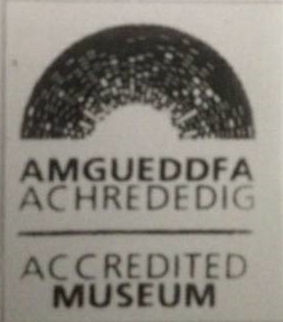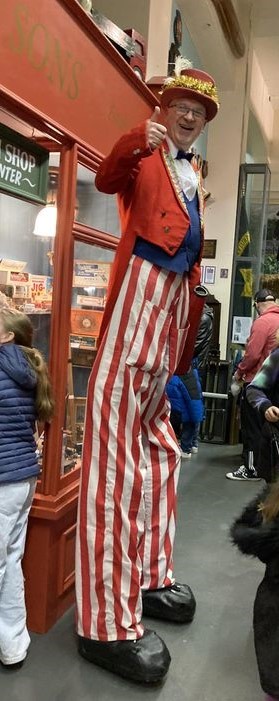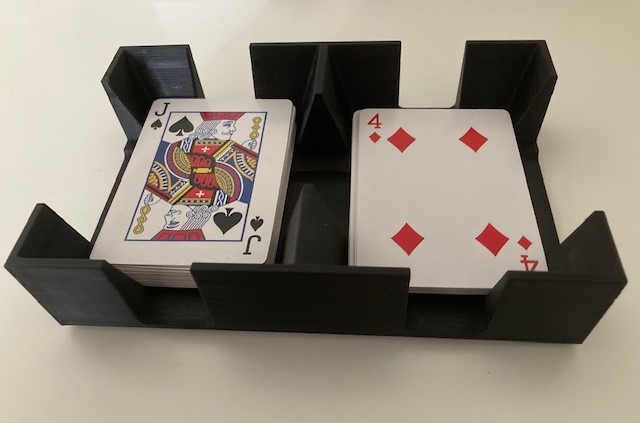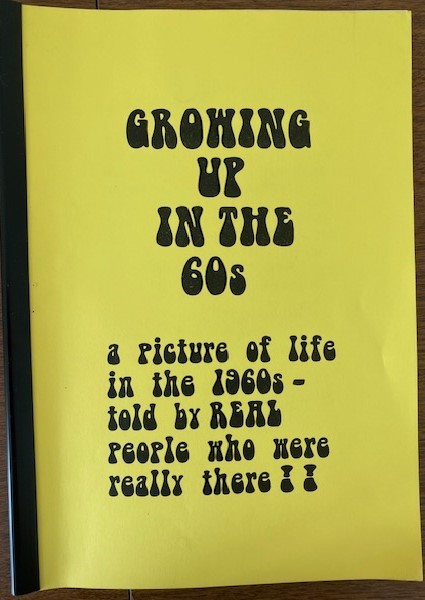What’s on at the Met Cinema
Fri 19th April at 7.30pm the Music of ELO. Tickets £20
Wed 24th April to Fri 26th April at 7pm and
Sat 27th April at 3pm, Brynmawr Musical Theatre Company presents Oklahoma. Tickets £14.
For more information visit or Tel 01495 533195
Museum Opening Times
The Museum is open to the public, free of charge:
Thursday* to Saturday 10am – 1pm
March 100 Club
This month’s prize numbers were drawn by member Denise Ewers and the lucky winners are:-
No. 57 Paul Pratley £20
No. 88 Matthew Price £10
If you would like to join our 100 club and be in with a chance of winning, it costs just £1 a month. Ask at the museum for further details.
Accreditation Application
 The museum is pleased to announce that our recent application for accredited status has been approved. In order to be accredited, we have to show, amongst other things, that we are looking after our collection of artefacts correctly. Our last award for accreditation was granted in 2016 and usually lasts five years, however, due to the pandemic, our accreditation was extended. The process has changed considerably since our last application and we would not have achieved accreditation without the tireless work of museum volunteer Mrs Jennifer Price, to whom we are extremely grateful. Jennifer has spent countless hours updating and writing over twenty policy documents to the required Spectrum standard (Spectrum being the UK museum collections management standard that is also used around the world). We would also like to thank our mentor Mrs Carol Whittaker, for her invaluable advice in what has been quite a complicated process. Being an accredited museum allows us to apply for grants from the Arts Council and allows us to display their logo on our literature etc. and secures the museum’s future for the next five years.
The museum is pleased to announce that our recent application for accredited status has been approved. In order to be accredited, we have to show, amongst other things, that we are looking after our collection of artefacts correctly. Our last award for accreditation was granted in 2016 and usually lasts five years, however, due to the pandemic, our accreditation was extended. The process has changed considerably since our last application and we would not have achieved accreditation without the tireless work of museum volunteer Mrs Jennifer Price, to whom we are extremely grateful. Jennifer has spent countless hours updating and writing over twenty policy documents to the required Spectrum standard (Spectrum being the UK museum collections management standard that is also used around the world). We would also like to thank our mentor Mrs Carol Whittaker, for her invaluable advice in what has been quite a complicated process. Being an accredited museum allows us to apply for grants from the Arts Council and allows us to display their logo on our literature etc. and secures the museum’s future for the next five years.
Springfest
 Springfest was a big success again this year with lots of visitors, including this interesting character! Thanks also to our President Mr Jack Hanbury for supporting us by attending the event. And of course thanks to our volunteers for manning the café, gift shop, egg hunt and raffle stall, without whom the event would have been a non-starter.
Springfest was a big success again this year with lots of visitors, including this interesting character! Thanks also to our President Mr Jack Hanbury for supporting us by attending the event. And of course thanks to our volunteers for manning the café, gift shop, egg hunt and raffle stall, without whom the event would have been a non-starter.
The Science of Star Trek
If you were to watch a 1966 episode of the original Star Trek series starring a young William Shatner, you might not think it very special today. However it featured things that did not exist in 1966 but which we now take for granted. From automatic doors to tablet computers; from video conferencing to voice recognition software; from computer chips to personal handheld ‘communicators’ – all featured in 1960s Star Trek when they were still but a ‘twinkle’ in a scientists eye. There was one piece of Star Trek technology tough that I thought would forever remain fiction. I refer to the ‘replicator’, which to those uninitiated in Star Trek, was a hole in the wall which, on command, could conjure up anything from a piece of equipment to a plate of food. However today even this is now becoming a reality albeit in its early stages. I am referring to the 3D printer.

The 3D printer adds a third dimension to printed objects by building depth. Very briefly, first the object to be ‘printed’ needs to be designed on a computer using specialist software. Once the design is complete it can be transferred to the printer. While a traditional 2D printer uses paper or card, the 3D printer uses mainly plastic. The plastic is heated up until it is very soft and the object is then built by adding layer upon layer – a bit like a knitting machine would make a piece of knitwear. Although these 3D machines are still relatively new, they are developing rapidly and are even being used to build replacement body parts such as noses and ears. Some even work with other materials to produce items of food. And in China, giant 3D printers are making buildings, yes buildings and very cheaply too!

I was recently gifted the plastic playing card holder pictured here which was made by my niece’s very clever husband, Barry Nel, using his home 3D printer which is also featured here. The plastic is fed into the printer from the spool you can see on the right-hand side.
1960s Star Trek was certainly a very accurate glimpse into the future, at least as far as technology is concerned, and it makes me wonder if scientists were inspired by Star Trek to make the science a reality, or would it have come about regardless? It’s that age-old chicken and egg conundrum. I never thought I would live to see the day of Star Trek’s ‘replicator’ so now I live in hope they will someday develop the matter transportation device…I wait to be beamed up Scotty!
Sally Murphy
Wikipedia 3d printering article
Mr Death Ray
Now here is a bit of science fiction for you – the death ray - and if you read on you will see that there is a Welsh connection. Scientifically this was a 'theoretical particle beam or electromagnetic weapon' – a theory that gained popularity in the 1920s and 30s but which was still being talked about in the 50s. I'm sure we have all seen old films featuring a 'death ray' but although we might dismiss such ideas as a load of nonsense, the modern world might now be said to have such a weapon in the form of laser weapon systems.
But let's go back to the 1920s. There were several people who claimed to have invented a death ray but this short piece will focus on a man called Harry Grindell Matthews. He claimed, in 1923, to have invented an electric ray that would put magnetos out of action and apparently gave a demonstration of stopping a motorcycle engine from a distance. He went on to claim that given a powerful enough machine, the invention could down planes, sink ships and stop armies from a distance of 4 miles. These claims were publicised in sensational accounts in the newspapers and by 1924 he had attracted the attention of the War Office. However, the military were understandably reluctant to hand over any money without having seen the machine in action.
Matthews continued to speak to journalists rather than the War Office. He allegedly used his machine to ignite gunpowder but he steadfastly refused to explain how the ray worked. Later that year he demonstrated, in his laboratory, that he could use the device to switch on a light bulb and cut off a motor but the Admiralty were not convinced. Matthews refused to give any further demonstrations and now comes the bit that reads like a spy chase. Matthews was determined to sell his invention to someone but his investors stepped in with an injunction which prevented him selling the rights to the death ray. When a representative turned up at his laboratory with a view to re-opening negotiations, Matthews was already on his way to France. A high speed chase ensued but by the time they reached Croydon airfield they were too late and Matthews had already left for France.
There was concern at government level that Matthews might sell his device to a foreign power (even though they were far from convinced it worked) and so once again they offered to buy his invention if he could prove it actually worked. Once again Matthews refused. He was offered even more money but still refused. He wanted the money but he wasn't prepared to give any proof that his invention worked. The press were ecstatic at how this story was playing out! In summer 1924 Matthews went to the USA but still refused to demonstrate his death ray device.
Matthews went on to continue to have a colourful life. He moved to Clydach near Swansea where he developed a laboratory at a bungalow surrounded by an electric fence topped by barbed wire, had his own airfield, claimed to have worked on aerial mines and a system to detect submarines and then in 1938 he became the fifth husband of an extremely wealthy Polish-American opera singer.
His hectic life proved too much for him and in 1941, at the age of 61, he died of a heart attack at his Clydach home. Matthews had some successful inventions but there is not enough time or space to recount them here. If you want to read more, my internet searches suggest you read a book called 'The Death Ray – the Secret Life of Harry Grindell Matthews' by Jonathan Foster.
Jen Price
iPhone Enhanced Security Feature
If you have an iPhone running iOS 17.3 or later, then you might be interested to know that this latest software update included a new game-changing security feature called ‘Stolen Device Protection’. It is designed to make your iPhone unattractive to thieves by requiring your Apple ID and password should a thief wish to make use of or wipe clean your iPhone to sell on. Learn more here
GROWING UP IN THE 60s
 From May 1994 to February 1995, a lady by the name of Francesca Kay visited Abertillery library once a month as part of a project supported by Gwent Libraries and the Arts Council of Wales. The purpose of her visits was to collect memories of the 1960s from visiting members of the public. The memories were put together in a booklet and recently, when emptying a cupboard at the museum, a copy of the booklet came to light. What follows are a few extractions from this booklet:
From May 1994 to February 1995, a lady by the name of Francesca Kay visited Abertillery library once a month as part of a project supported by Gwent Libraries and the Arts Council of Wales. The purpose of her visits was to collect memories of the 1960s from visiting members of the public. The memories were put together in a booklet and recently, when emptying a cupboard at the museum, a copy of the booklet came to light. What follows are a few extractions from this booklet:
There was a local Abertillery group called the Tumbleweeds. They were immensely popular. They had a lead singer who couldn’t pronounce his ‘r’s. When he sang Blueberry Hill, he sang ‘Twa la la’ instead of ‘Tra la la’. He was known locally as Twala.
J Smith
When colour TV came in, I thought it was fantastic. My husband’s family in Brynithel had one of the first colour TVs, and people would stand outside the window and look in on it. Life in general changed when TV came in. People used to get together more to talk, but now with TV, conversation stops. It’s also a great waste of precious time.
Mrs Osland
A lot of dances were held downstairs in the Market Hall* with a proper polished dance floor. There was a regular Saturday evening dance. George Howard and his Band were a four or five piece band, playing quicksteps, foxtrots and tangos. Men wore a suit and tie. The women wore dresses or full skirts of black. They had dance shoes they changed into when they arrived. There was an MC [Master of Ceremonies] who introduced the dances, and also showed any new dances and steps.
I remember the Whitsun school walks. Every chapel and church would come out onto the street. There was a big procession through town, with everyone singing. And afterwards there was tea for the children. People from outside the town would come in to watch. The pubs had extended licences. That was the time when people bought new clothes for ‘best’. Chapels provided social activities for young people to meet. There were annual outings, to Barry Island or Porthcawl or Stratford upon Avon. A lot of children wouldn’t have had an outing without it. Later on, the dances were where people met.
G Rowlands
(*now the museum of course.)
June 1960 was the explosion in Six Bells [pit]. After the explosion a fund was opened for the bereaved. I was on the committee. We were able to give immediate help for people in need of it. There was such generosity. For instance, one lady who had a camp site lent it for children to have a holiday. The feeling was so strong, everyone clung together and helped each other. The miners of Czechoslovakia invited fifteen of us out to convalesce. There were relatives, survivors, and old people. In the convalescent home up in the mountains there were Belgians, Czechs, Italians and us, all together. I played the piano and one time, in the big hall, our leader said ‘Go on Bert, play the Hokey Cokey. In the end we got them all dancing!
Mr Snellgrove
We had motorcycles, and used to wear leather jackets. It was the fashion to wear a leather belt with studs, in the shape of stars and horseshoes. I was riding through town on my motorbike and the police flagged me down and told me not to wear my studded belt as it was an offensive weapon!
D Bearcroft
This book with its bright yellow cover is out on display at the museum. Please feel free to have a read of it on your next visit.
Top Of Page
© Abertillery & District Museum 2024 
